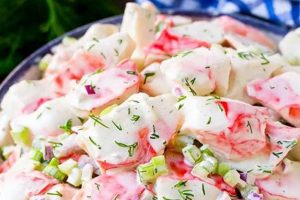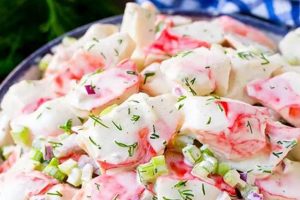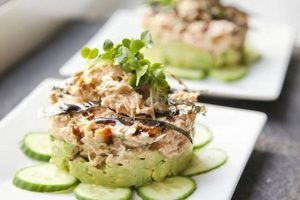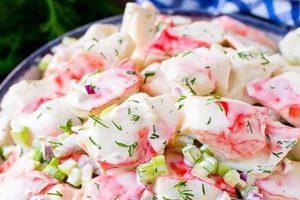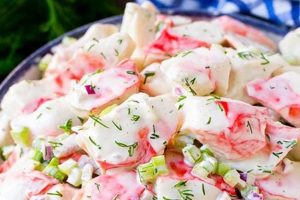Surimi, a processed fish product often fashioned into crab-like sticks or flakes, offers a versatile and affordable ingredient for various cold seafood salads. These salads typically combine surimi with mayonnaise, vegetables like celery and onion, and seasonings. A simple example involves mixing flaked surimi with mayonnaise, chopped celery, diced onion, a dash of lemon juice, and Old Bay seasoning.
The accessibility and cost-effectiveness of surimi contribute to its popularity as a crab substitute. It provides a mild flavor profile that readily absorbs other ingredients’ tastes, making it adaptable to diverse flavor combinations. While not a direct nutritional equivalent to real crab, surimi can be a source of protein. Historically, surimi production originates from East Asia, where it has been a culinary staple for centuries. Its adaptation into western cuisine introduced a convenient way to enjoy the essence of seafood salads without the expense of shellfish.
Further exploration of this topic will delve into specific recipe variations, nutritional comparisons between surimi and genuine crab meat, the history and evolution of surimi production, and potential health considerations.
Tips for Utilizing Surimi in Seafood Salad
Optimizing surimi in seafood salads involves understanding its properties and employing techniques that enhance flavor and texture. The following tips offer guidance for creating successful dishes.
Tip 1: Thaw Thoroughly: Ensure complete thawing of frozen surimi before incorporating it into the salad. This prevents a watery consistency and allows for even mixing with other ingredients.
Tip 2: Enhance Texture: Dicing or shredding surimi creates textural variety, mimicking the appearance of real crab meat and improving the overall mouthfeel of the salad.
Tip 3: Balance Flavors: Surimi’s mild taste benefits from bold seasonings. Experiment with Old Bay, dill, lemon juice, or horseradish to create a well-rounded flavor profile.
Tip 4: Mindful Mayonnaise Use: Overuse of mayonnaise can lead to a heavy and overly rich salad. Start with a smaller amount and adjust according to desired creaminess, considering Greek yogurt as a lighter alternative.
Tip 5: Incorporate Fresh Ingredients: Elevate the salad with fresh vegetables such as chopped celery, bell peppers, red onion, or water chestnuts. These additions contribute both flavor and textural contrast.
Tip 6: Chill Before Serving: Allowing the salad to chill in the refrigerator for at least 30 minutes enhances flavor development and allows the ingredients to meld.
Tip 7: Consider Garnishes: A sprinkle of paprika, chopped fresh parsley, or a wedge of lemon can enhance presentation and add a final touch of flavor.
By following these tips, one can create flavorful and satisfying seafood salads using surimi, maximizing its potential as a versatile and affordable ingredient.
This practical guidance allows for the creation of dishes that satisfy both in terms of taste and presentation, highlighting the versatility of surimi as a key ingredient.
1. Ingredient Quality
Ingredient quality significantly impacts the overall success of seafood salad recipes utilizing imitation crab. Superior ingredients elevate flavor, texture, and nutritional value, resulting in a more satisfying culinary experience. Careful selection of components ensures a cohesive and balanced final product.
- Surimi Selection
Surimi quality varies depending on processing methods and ingredients. Higher-grade surimi typically contains a higher percentage of fish and fewer additives, resulting in a firmer texture and a cleaner flavor. Opting for premium surimi minimizes the “fishy” taste sometimes associated with lower-quality products. This choice directly influences the salad’s overall palatability.
- Freshness of Produce
Incorporating fresh, crisp vegetables enhances both the flavor and textural complexity of the salad. Wilted or less-than-fresh produce detracts from the overall sensory experience. Selecting vibrant, in-season vegetables ensures optimal flavor and contributes to a visually appealing final dish.
- Mayonnaise Choice
Mayonnaise acts as a binding agent and contributes to the salad’s overall richness and flavor. The quality of the mayonnaise significantly influences the final taste. Using a high-quality mayonnaise, or exploring alternatives like Greek yogurt, elevates the flavor profile and allows for better control over the salad’s creaminess and tanginess.
- Seasoning and Flavor Enhancers
Thoughtfully selected seasonings and flavor enhancers amplify the taste of the surimi and other ingredients. Fresh herbs, spices, and citrus juices contribute brightness and complexity. The balance and quality of these additions play a crucial role in achieving a well-rounded and flavorful salad.
By prioritizing ingredient quality across all components, from the surimi itself to the supporting vegetables, seasonings, and binding agents, one ensures a superior seafood salad. The interplay of these high-quality ingredients contributes to a cohesive dish that satisfies both in terms of taste and texture, demonstrating a commitment to culinary excellence even with a budget-friendly protein source like surimi.
2. Flavor Balance
Flavor balance represents a crucial aspect of successful seafood salad recipes incorporating imitation crab. Surimi, often used as an imitation crab, possesses a mild, inherently sweet flavor profile. This neutrality necessitates careful consideration of complementary ingredients and seasonings to achieve a palatable and well-rounded taste. The delicate flavor of surimi provides a blank canvas, allowing other ingredients to shine while avoiding overwhelming the overall composition.
A harmonious flavor profile typically incorporates elements of saltiness, acidity, and umami to counterbalance the surimi’s sweetness. Salt, often introduced through ingredients like celery or seasonings such as Old Bay, provides a foundational savory element. Acidity, derived from lemon juice or vinegar, cuts through the richness of mayonnaise and adds brightness. Umami, achievable through ingredients like Worcestershire sauce or a touch of Dijon mustard, contributes depth and complexity. For example, a classic seafood salad might balance the sweetness of surimi with the salty crunch of celery, the tangy zest of lemon, and the subtle umami notes of dill. Without this careful balance, the salad can taste bland or overly sweet, failing to showcase the potential of surimi as a versatile ingredient.
Achieving optimal flavor balance requires an understanding of individual ingredient contributions and their interplay within the overall composition. It involves a nuanced approach, recognizing the delicate nature of surimi and adjusting complementary flavors accordingly. This meticulous attention to flavor balance elevates the dish beyond a simple combination of ingredients, transforming it into a harmonious and satisfying culinary experience. The delicate balance emphasizes the versatility of surimi, allowing it to shine within a complex flavor profile, ultimately enhancing enjoyment and showcasing the potential of seafood salads featuring imitation crab.
3. Textural Variety
Textural variety plays a vital role in the overall enjoyment of seafood salad recipes featuring imitation crab. Surimi, while offering a pleasant, mildly sweet flavor, often possesses a uniformly soft texture. This homogeneity can lead to a monotonous mouthfeel if not addressed through the incorporation of texturally diverse ingredients. The interplay of contrasting textures elevates the sensory experience, transforming a simple salad into a more dynamic and engaging dish.
Consider the contrast achieved by combining the soft, slightly chewy texture of surimi with the crisp snap of celery, the firm bite of bell peppers, and the satisfying crunch of water chestnuts. These contrasting elements create a multi-dimensional textural landscape within each bite. Further textural intrigue can be introduced through toasted nuts or seeds, providing a welcome counterpoint to the softer elements. Even the choice of surimi itself can contribute to textural variation. Shredded surimi offers a finer texture compared to larger chunks or flakes, allowing for a more nuanced interplay with other ingredients. For example, a finely shredded surimi salad containing finely diced celery and onion creates a more delicate textural profile than a salad featuring larger chunks of surimi and coarsely chopped vegetables.
The absence of textural variety can result in a bland and uninspiring culinary experience, regardless of how well-balanced the flavors might be. A uniformly soft salad lacks the dynamism and interest that contrasting textures provide. Understanding the importance of textural interplay allows for strategic ingredient selection and preparation techniques to maximize the enjoyment of seafood salads featuring imitation crab. This attention to detail elevates the dish, demonstrating a thoughtful approach to culinary construction and a commitment to creating a truly satisfying sensory experience. The careful consideration of texture ultimately transforms a simple combination of ingredients into a more complex and rewarding culinary creation.
4. Preparation Techniques
Preparation techniques significantly influence the final quality and enjoyment of seafood salad recipes using imitation crab (surimi). Proper handling and processing of ingredients contribute to optimal flavor, texture, and overall presentation. Careful attention to these techniques ensures a cohesive and appealing dish, maximizing the potential of surimi as a versatile and affordable seafood salad component.
- Surimi Handling
Thawing surimi completely before incorporating it into the salad is essential. Incomplete thawing can lead to excess moisture, diluting the flavors and creating a watery consistency. Gentle handling prevents the delicate surimi from breaking down excessively, maintaining its desirable texture. Over-mixing can also result in a mushy texture, so a light touch is recommended when combining surimi with other ingredients. Proper thawing and gentle handling preserve the integrity of the surimi, allowing it to contribute its intended flavor and texture to the finished salad.
- Ingredient Incorporation
The order in which ingredients are incorporated impacts the final texture and flavor distribution. Generally, drier ingredients, such as chopped vegetables, are added first, followed by the surimi. Mayonnaise or other dressings are added last and mixed gently to coat all ingredients evenly, preventing the salad from becoming overly saturated. This staged approach ensures even distribution of flavors and prevents the salad from becoming overly wet or heavy.
- Chilling and Resting
Chilling the prepared salad allows the flavors to meld and develop fully. A minimum of 30 minutes of refrigeration is recommended to allow the ingredients to harmonize and the flavors to deepen. Chilling also firms the salad, making it easier to serve and enhancing its textural appeal. This resting period allows the flavors to marry and creates a more cohesive and satisfying overall taste experience.
- Presentation and Garnishing
Thoughtful presentation elevates the visual appeal of the seafood salad. Using attractive serving dishes and appropriate garnishes enhances the dining experience. Fresh herbs, a sprinkle of paprika, or a lemon wedge add visual interest and complement the flavors of the salad. These finishing touches demonstrate attention to detail and elevate the perceived quality of the dish.
These preparation techniques, though seemingly simple, collectively contribute significantly to the overall success of seafood salad recipes using imitation crab. Attention to detail in each step, from thawing and handling the surimi to chilling and presentation, ensures a flavorful, visually appealing, and texturally satisfying dish. These techniques maximize the potential of surimi, transforming it from a simple ingredient into the star of a well-executed and enjoyable seafood salad.
5. Presentation
Presentation significantly impacts the perceived quality and enjoyment of seafood salad featuring imitation crab. While flavor and texture undoubtedly contribute to a positive culinary experience, visual appeal plays a crucial role in initial perceptions and overall satisfaction. A well-presented salad entices the diner, creating anticipation and enhancing the sensory experience beyond taste and texture alone. Conversely, a carelessly plated salad, regardless of its inherent quality, can diminish appetite and negatively influence perceived value. This principle applies universally, but carries particular weight when working with imitation crab, which sometimes suffers from negative preconceptions regarding its appearance.
Several factors contribute to effective seafood salad presentation. The choice of serving vessel influences perception. A simple, elegant bowl or platter allows the salad to take center stage. Garnishes provide visual interest and can complement the flavors of the dish. Fresh herbs, such as dill or parsley, add brightness and a touch of elegance. A sprinkle of paprika or a wedge of lemon provides a pop of color and reinforces the seafood theme. Portion size also influences perception. Overly large portions can appear overwhelming, while too-small portions may suggest frugality or lack of generosity. Consider the context a buffet setting might warrant larger portions than an individual plated salad. In a restaurant setting, a professionally plated salad featuring imitation crab, artfully garnished and served in an appropriate vessel, elevates the perceived value and combats potential biases against the use of a substitute ingredient. Conversely, a home-prepared salad served in a plain bowl without garnishes might be perceived as less appealing, even if the flavor profile is identical.
Effective presentation elevates seafood salad featuring imitation crab, transforming it from a simple dish into a more refined and appealing culinary creation. Consideration of visual elements, including serving vessels, garnishes, and portion size, demonstrates attention to detail and enhances the overall dining experience. This careful attention to presentation mitigates potential negative perceptions associated with imitation crab, allowing diners to fully appreciate the flavors and textures of the dish. Ultimately, skillful presentation enhances enjoyment and contributes to a more satisfying culinary experience.
6. Nutritional Value
Nutritional value represents a key consideration in seafood salad recipes featuring imitation crab (surimi). While surimi offers a cost-effective and versatile alternative to traditional crab meat, its nutritional profile differs significantly. Understanding these differences allows for informed dietary choices and recipe adjustments to maximize nutritional benefits.
Surimi generally contains less protein and omega-3 fatty acids compared to real crab. It often includes added carbohydrates, starches, and sugars for texture and flavor. However, surimi can be a source of certain vitamins and minerals, depending on the specific brand and processing methods. For example, some brands may fortify surimi with vitamin B12 or omega-3s to enhance its nutritional value. Comparing nutrition labels between real crab and various surimi brands allows consumers to make informed choices based on individual dietary needs. A salad featuring surimi, fresh vegetables, and a light dressing can contribute to a balanced meal, particularly when portion sizes are considered. Adding ingredients like avocado or nuts can further enhance the nutritional profile of the salad, providing healthy fats and additional vitamins and minerals.
Recipes featuring imitation crab offer dietary flexibility. Ingredient choices and portion control influence the overall nutritional value. Awareness of these factors empowers individuals to create seafood salads that align with individual health goals, demonstrating that flavorful and nutritious meals featuring imitation crab are attainable with informed choices. This knowledge enables individuals to maximize the nutritional benefits while enjoying the convenience and affordability of surimi.
7. Cost-Effectiveness
Cost-effectiveness represents a significant advantage of seafood salad recipes utilizing imitation crab. Real crab meat carries a substantially higher price tag, often making it inaccessible for budget-conscious consumers or large-scale meal preparation. Imitation crab, derived from surimi, offers a significantly more affordable alternative, allowing for broader accessibility to crab-flavored dishes. This affordability becomes particularly relevant when preparing seafood salads for larger gatherings or incorporating them into regular meal planning. The cost difference can be substantial, with imitation crab often costing a fraction of the price of real crab meat per pound. This cost advantage allows consumers to enjoy the flavor and versatility of a crab-like ingredient without the associated financial burden.
This cost-effectiveness allows for greater culinary experimentation and broader recipe adaptation. Consumers can explore various flavor combinations and ingredient pairings without the financial constraints imposed by the cost of real crab. For example, a recipe calling for a significant quantity of crab meat for a large gathering becomes economically feasible when utilizing imitation crab. This affordability also facilitates the inclusion of other premium ingredients, such as high-quality vegetables or artisanal mayonnaise, without exceeding budgetary limitations. This balance enhances the overall dining experience, making it possible to create flavorful and visually appealing seafood salads while maintaining fiscal responsibility. In practical terms, this translates to more frequent enjoyment of seafood salads, contributing to dietary variety and potentially increased seafood consumption within budget constraints. Consider a family regularly enjoying seafood salad thanks to the affordability of imitation crab, an option otherwise unavailable if relying solely on real crab meat.
The cost-effectiveness of imitation crab contributes significantly to the accessibility and versatility of seafood salad recipes. This affordability expands culinary possibilities, allowing for greater experimentation and more frequent enjoyment. While acknowledging the nutritional and flavor differences compared to real crab, the economic advantages of surimi position it as a valuable ingredient for budget-conscious consumers and those seeking creative culinary exploration. The cost-effectiveness of imitation crab democratizes access to seafood-inspired dishes, enabling a wider range of individuals to enjoy flavorful and satisfying meals without compromising financial resources. This economic benefit directly addresses concerns about food affordability and promotes culinary creativity, showcasing the practical value of imitation crab in diverse dietary and economic contexts.
Frequently Asked Questions
This FAQ section addresses common inquiries regarding the use of imitation crab in seafood salad, offering clarity and dispelling misconceptions.
Question 1: What exactly is imitation crab?
Imitation crab, also known as surimi, is a processed seafood product typically made from white fish, such as pollock or cod. It is minced, shaped, and flavored to resemble the taste and texture of crab meat.
Question 2: Is imitation crab healthy?
While not a direct nutritional equivalent to real crab, surimi can be a source of protein. However, it often contains additives, including starches, sugars, and flavor enhancers. Nutritional content varies depending on the brand, so checking labels is recommended.
Question 3: How can one tell the difference between real crab and imitation crab in a salad?
Real crab typically exhibits a more fibrous, flaky texture and a sweeter, more delicate flavor. Imitation crab tends to have a more uniform, slightly chewy texture and a milder taste.
Question 4: Can imitation crab be used interchangeably with real crab in recipes?
While surimi can substitute for real crab in many recipes, including seafood salad, the flavor and texture will differ. Recipes may require adjustments to seasonings or other ingredients to account for these differences.
Question 5: How should imitation crab be stored and handled?
Imitation crab should be stored according to package instructions, typically refrigerated or frozen. Thawing completely before use is crucial for optimal texture in salads. Gentle handling prevents the surimi from breaking down and becoming mushy.
Question 6: Are there any allergies to consider when using imitation crab?
Individuals with shellfish allergies should exercise caution when consuming imitation crab, as it is often processed in facilities that also handle shellfish. Additionally, surimi is typically made from fish, so individuals with fish allergies should avoid it.
Careful consideration of these points allows for informed choices regarding the inclusion of imitation crab in seafood salad, ensuring both culinary satisfaction and dietary awareness.
Further exploration of this topic might include a detailed recipe section or a comparison of different brands of imitation crab available on the market.
Conclusion
Exploration of seafood salad recipes utilizing imitation crab reveals a nuanced interplay of factors influencing culinary outcomes. Ingredient quality, flavor balance, textural variety, preparation techniques, presentation, nutritional value, and cost-effectiveness collectively determine the success of these dishes. Surimi, while not a direct nutritional replacement for real crab, offers affordability and versatility, broadening access to seafood-inspired cuisine. Careful consideration of these elements allows for informed choices, enabling culinary creativity within budgetary constraints.
Strategic ingredient selection and meticulous preparation techniques maximize the potential of surimi in seafood salads. Recognizing the inherent differences between surimi and real crab allows for informed recipe adaptation and flavor balancing. Continued exploration of culinary applications and evolving production technologies promises further enhancement of surimi-based dishes, ensuring their enduring presence in diverse culinary landscapes. The adaptability of surimi underscores its value as a key component in accessible and enjoyable seafood salad creations.

